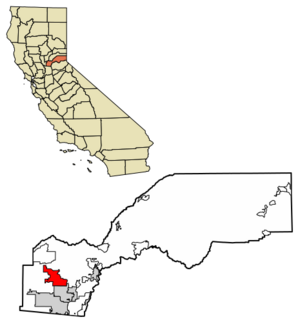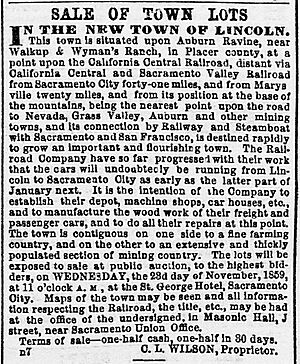Lincoln, California facts for kids
Quick facts for kids
Lincoln, California
|
||
|---|---|---|
|
City
|
||
| City of Lincoln | ||
|
Woman's Club of Lincoln (left) and downtown (right)
|
||
|
||

Location of Lincoln in Placer County, California
|
||
| Country | United States | |
| State | California | |
| County | Placer | |
| Incorporated | August 7, 1890 | |
| Government | ||
| • Type | Council–manager | |
| Area | ||
| • Total | 23.55 sq mi (61.00 km2) | |
| • Land | 23.51 sq mi (60.89 km2) | |
| • Water | 0.04 sq mi (0.11 km2) 0.12% | |
| Elevation | 167 ft (51 m) | |
| Population
(2020)
|
||
| • Total | 49,757 | |
| • Density | 2,053.4/sq mi (792.81/km2) | |
| Time zone | UTC-8 (Pacific) | |
| • Summer (DST) | UTC-7 (PDT) | |
| ZIP code |
95648
|
|
| Area code | 916, 279 | |
| FIPS code | 06-41474 | |
| GNIS feature ID | 277539 | |
Lincoln is a city in Placer County, California, United States. It is part of the Sacramento metropolitan area. Lincoln is located about 10 miles (16 km) north of Roseville.
The city has grown very quickly. Between 2000 and 2010, its population increased by 282 percent. This made Lincoln the fastest-growing city in the U.S. with over 10,000 people. In 2019, about 48,275 people lived there. Lincoln is also part of the larger Sacramento-Roseville Metropolitan Statistical Area.
Contents
History of Lincoln
Founding the Railroad Town
The city of Lincoln was first planned in 1859 by Theodore Judah. He was working on the new California Central Railroad. The town was named after Charles Lincoln Wilson. He helped organize and raise money for the railroad.
The railroad was meant to connect Marysville and Sacramento. It would link up with another railroad in Folsom. Construction started in 1858. By 1859, the tracks reached Grider's Ranch, which is now Roseville.
Lincoln was chosen as a new railroad town where the line turned north. Charles Lincoln Wilson sold lots in the new town. At an auction in Sacramento on November 23, 1859, over $4,000 was made from selling these lots. Prices for each lot ranged from $20 to $400.
Track laying began on December 30, 1859. With help from Chinese workers, the railroad reached Lincoln on October 14, 1861. The arrival of the railroad changed the area. It brought life to the new town. Lincoln was likely the first planned railroad town in California.
Growth and New Industries
For a short time, Lincoln was the end of the railroad line. This caused a small boom in the town. But soon, more money was found. The railroad was extended to Wheatland. This ended Lincoln's first period of growth.
The town became quiet for a while. Then, in the early 1870s, rich clay deposits were found nearby. This led to the creation of Gladding, McBean & Co.. This company made pottery. Lincoln became famous for its pottery. This brought a new time of growth and success to the town.
Lincoln remained a quiet town until the mid-1990s. That's when the suburbs of Sacramento began to expand. This new growth reached Lincoln. By the 2010 census, Lincoln's population was 42,819. This was a huge increase of 282 percent since 2000. It made Lincoln the fastest-growing city in the United States during that decade.
In June 2003, the Thunder Valley Casino Resort opened in Lincoln. It was the first casino in the greater Sacramento area. In 2006, Lincoln was named an All-America City by the National Civic League. It was the only city in California to receive this special award that year.
Geography of Lincoln
Lincoln is located at 38°53′14″N 121°17′46″W / 38.88722°N 121.29611°W. The city covers a total area of about 20.1 square miles (52.1 km²). Only a very small part of this area, about 0.02 square miles (0.05 km²), is water.
Climate in Lincoln
Lincoln has a hot-summer Mediterranean climate. This means it has cool, wet winters and hot, dry summers. The wet season usually runs from October to April. Lincoln gets almost 250 sunny days each year.
During summer, days can be very hot. The average high in July is 94°F (34°C). Temperatures can even reach 104°F (40°C) or higher for several weeks. A cool breeze from the Bay Area helps lower night temperatures. Spring and fall are short seasons with mild weather.
In winter, temperatures are quite chilly. The average low in January is 39°F (4°C). Temperatures can sometimes drop below freezing, but this is not common. Lincoln receives about 20.45 inches (520 mm) of rain each year. Snowfall is very rare in Lincoln, but it does happen sometimes.
| Climate data for Lincoln, California | |||||||||||||
|---|---|---|---|---|---|---|---|---|---|---|---|---|---|
| Month | Jan | Feb | Mar | Apr | May | Jun | Jul | Aug | Sep | Oct | Nov | Dec | Year |
| Record high °F (°C) | 75 (24) |
78 (26) |
86 (30) |
98 (37) |
107 (42) |
110 (43) |
115 (46) |
110 (43) |
111 (44) |
102 (39) |
87 (31) |
76 (24) |
115 (46) |
| Mean daily maximum °F (°C) | 56 (13) |
61 (16) |
66 (19) |
72 (22) |
81 (27) |
90 (32) |
95 (35) |
95 (35) |
89 (32) |
79 (26) |
65 (18) |
56 (13) |
75 (24) |
| Daily mean °F (°C) | 46 (8) |
50 (10) |
55 (13) |
60 (16) |
66 (19) |
74 (23) |
78 (26) |
77 (25) |
73 (23) |
64 (18) |
54 (12) |
46 (8) |
62 (17) |
| Mean daily minimum °F (°C) | 36 (2) |
39 (4) |
43 (6) |
47 (8) |
52 (11) |
58 (14) |
61 (16) |
61 (16) |
57 (14) |
49 (9) |
41 (5) |
37 (3) |
48 (9) |
| Record low °F (°C) | 21 (−6) |
22 (−6) |
27 (−3) |
28 (−2) |
33 (1) |
39 (4) |
47 (8) |
45 (7) |
37 (3) |
27 (−3) |
23 (−5) |
16 (−9) |
16 (−9) |
| Average precipitation inches (mm) | 3.98 (101) |
3.46 (88) |
3.07 (78) |
1.58 (40) |
0.58 (15) |
0.12 (3.0) |
0.04 (1.0) |
0.06 (1.5) |
0.35 (8.9) |
1.08 (27) |
2.80 (71) |
3.33 (85) |
20.45 (519.4) |
| Average precipitation days | 9 | 8 | 9 | 5 | 3 | 1 | 1 | 1 | 1 | 3 | 7 | 9 | 57 |
| Source: http://www.myforecast.com/bin/climate.m?city=11897&zip_code=95648&metric=false | |||||||||||||
Population and People
| Historical population | |||
|---|---|---|---|
| Census | Pop. | %± | |
| 1880 | 275 | — | |
| 1890 | 961 | 249.5% | |
| 1900 | 1,061 | 10.4% | |
| 1910 | 1,402 | 32.1% | |
| 1920 | 1,325 | −5.5% | |
| 1930 | 2,094 | 58.0% | |
| 1940 | 2,044 | −2.4% | |
| 1950 | 2,410 | 17.9% | |
| 1960 | 3,197 | 32.7% | |
| 1970 | 3,176 | −0.7% | |
| 1980 | 4,132 | 30.1% | |
| 1990 | 7,248 | 75.4% | |
| 2000 | 11,205 | 54.6% | |
| 2010 | 42,819 | 282.1% | |
| 2020 | 49,757 | 16.2% | |
| U.S. Decennial Census | |||
Population in 2010
According to the 2010 census, Lincoln had a population of 42,819 people. The population density was about 2,127 people per square mile (821 people/km²).
Most of the people in Lincoln were White (79.6%). Other groups included:
- African American (1.5%)
- Native American (0.9%)
- Asian (6.2%)
- Pacific Islander (0.3%)
- People from other races (7.3%)
- People of two or more races (4.2%)
About 17.7% of the people were Hispanic or Latino.
There were 16,479 households in Lincoln. About 31.5% of these households had children under 18 living there. Most households (62.9%) were married couples. The average household had 2.59 people. The average family had 3.01 people.
About 24.2% of the population was under 18 years old. About 23.5% of the population was 65 years or older. The average age in Lincoln was 40.5 years.
Population in 2000
In the 2000 census, Lincoln had 11,205 people. There were 3,874 households, with 3,033 of them being families. The population density was about 612 people per square mile (236 people/km²).
The racial makeup was similar to 2010, with 79.64% White. About 25.98% of the population was Hispanic or Latino.
About 30% of the population was under 18 years old. About 11.3% of the population was 65 or older. The average age was 32 years.
See also
 In Spanish: Lincoln (California) para niños
In Spanish: Lincoln (California) para niños






